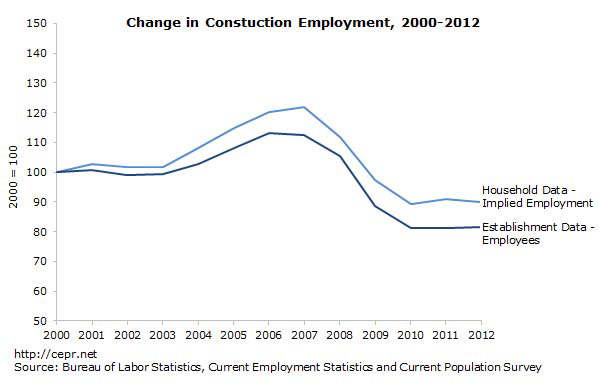Fiscal cliff concerns appear to have no impact whatsoever on hiring.
The unemployment rate edged up slightly to 7.9 percent in January as the economy added 157,000 jobs in the month. The unemployment rate has essentially been unchanged the last five months. The January job growth was pretty much in line with expectations, but growth for the prior two months was revised up by 127,000. This brings the average rate of job growth over the last three months to 200,000, considerably better than the average of 168,000 over the last year.
There were few noteworthy changes in the household data. There was a 0.4 percentage point rise in the unemployment rate for white men to 6.6 percent due to an influx of people looking for work. This could be a sign of the unemployed being more optimistic about their job prospects, but it may also just be an erratic fluctuation in the data. The participation rate for white men had fallen by 0.2 percentage points from October to December. The employment-population ratio for workers with just a high school degree fell by 0.3 percentage points to 54.0 percent, a new low for the downturn.
All the duration measures of unemployment fell sharply in January. The average duration of unemployment spells fell by 2.8 weeks, the largest drop ever. The median duration fell by 2 weeks and the share of long-term unemployed fell by 1.0 percentage points. This decline undoubtedly reflects the shortening of the period of extended benefits after the fiscal cliff deal. Since workers are required to look for jobs to get benefits, it appears that many of the unemployed stopped looking for work when their benefits expired and therefore are no longer counted as unemployed.
With the upward revisions to the November and December data, the picture in the establishment survey looks somewhat brighter. However, it is likely that these numbers are at least somewhat inflated due to unusually warm weather. There was a similar story last year with the winter months showing relatively good job growth. The result was that hiring was moved forward and the spring months then looked exceptionally weak. We may see the same story this year.
Retail trade, construction, and health care were the big job gainers in December, adding 32,000, 28,000, and 22,000 jobs, respectively. Retail has added an average of 37,000 jobs a month over the last three months. Health care has added an average of 31,000 jobs over this period.
Construction has added an average of 27,000 jobs a months since October. This rise is also in part attributable to unusually warm weather as well as repairs after Hurricane Sandy. However it may also be partly attributable to the bounce back in housing construction.

It is worth noting the divergence in construction employment as measured in the household survey and jobs as measured in the establishment survey. The former rose considerably more during the boom in the last decade and fell somewhat more in the downturn. This likely reflects undocumented workers in the industry who are likely working off the books.
Other sectors generally showed weak growth in January. Manufacturing added just 4,000 jobs. With downward revisions to the prior month’s data (the December report showed manufacturing adding 25,000 jobs), job growth in the sector has averaged just 6,000 since October. Temp sector employment fell by 8,000, almost completely reversing the gain in December. Restaurant employment rose by 17,000, roughly in line with its growth over the prior two months.
Government employment edged down by 9,000, roughly the same as its pace over the last year. Average weekly hours were unchanged in January, while average hours for production workers were down by 0.1 hours. Compared with year-ago levels, average hours for production workers are down by 0.2 hours, while average hours for all workers are down by 0.1 hour. Average hourly wage growth has picked up somewhat recently, rising at a 2.7 percent annual rate over the last three months. However, the data are sufficiently erratic, so this could be an aberration.
This report shows a picture of an economy that is growing slightly more rapidly than its potential. While this growth pace is consistent with modest declines in unemployment, that may not be true when the effects of deficit reduction are felt.
Truthout Is Preparing to Meet Trump’s Agenda With Resistance at Every Turn
Dear Truthout Community,
If you feel rage, despondency, confusion and deep fear today, you are not alone. We’re feeling it too. We are heartsick. Facing down Trump’s fascist agenda, we are desperately worried about the most vulnerable people among us, including our loved ones and everyone in the Truthout community, and our minds are racing a million miles a minute to try to map out all that needs to be done.
We must give ourselves space to grieve and feel our fear, feel our rage, and keep in the forefront of our mind the stark truth that millions of real human lives are on the line. And simultaneously, we’ve got to get to work, take stock of our resources, and prepare to throw ourselves full force into the movement.
Journalism is a linchpin of that movement. Even as we are reeling, we’re summoning up all the energy we can to face down what’s coming, because we know that one of the sharpest weapons against fascism is publishing the truth.
There are many terrifying planks to the Trump agenda, and we plan to devote ourselves to reporting thoroughly on each one and, crucially, covering the movements resisting them. We also recognize that Trump is a dire threat to journalism itself, and that we must take this seriously from the outset.
Last week, the four of us sat down to have some hard but necessary conversations about Truthout under a Trump presidency. How would we defend our publication from an avalanche of far right lawsuits that seek to bankrupt us? How would we keep our reporters safe if they need to cover outbreaks of political violence, or if they are targeted by authorities? How will we urgently produce the practical analysis, tools and movement coverage that you need right now — breaking through our normal routines to meet a terrifying moment in ways that best serve you?
It will be a tough, scary four years to produce social justice-driven journalism. We need to deliver news, strategy, liberatory ideas, tools and movement-sparking solutions with a force that we never have had to before. And at the same time, we desperately need to protect our ability to do so.
We know this is such a painful moment and donations may understandably be the last thing on your mind. But we must ask for your support, which is needed in a new and urgent way.
We promise we will kick into an even higher gear to give you truthful news that cuts against the disinformation and vitriol and hate and violence. We promise to publish analyses that will serve the needs of the movements we all rely on to survive the next four years, and even build for the future. We promise to be responsive, to recognize you as members of our community with a vital stake and voice in this work.
Please dig deep if you can, but a donation of any amount will be a truly meaningful and tangible action in this cataclysmic historical moment.
We’re with you. Let’s do all we can to move forward together.
With love, rage, and solidarity,
Maya, Negin, Saima, and Ziggy
